Manhattan’s 843-acre oasis is vast enough so that quite a bit of it is rarely trodden by the public…which passes some highlights by without giving them a second glance. How’s that for circumlocution. Enough circumlocution…let’s do some circumambulating in the park. The sun is out for once.
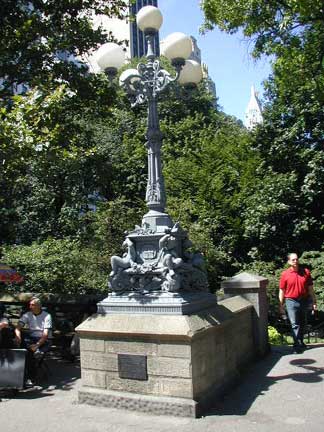
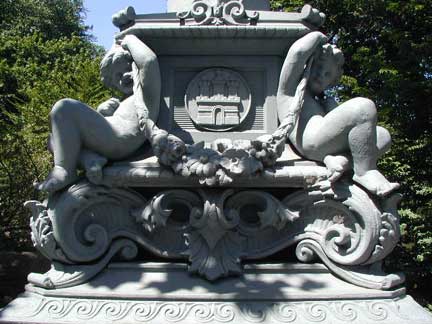
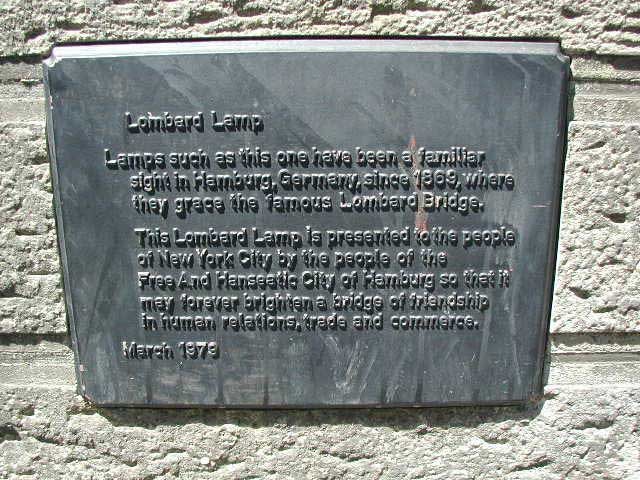
LOMBARD LAMP
This lamp was donated by Hamburg, West Germany in 1979 and is a replica of an ornate lamp found in Hamburg at the Lombard Bridge. The plaque reads “This Lombard Lamp is presented to the people of New York City and by the people of the Free and Hanseatic City of Hamburg so that it may forever brighten a bridge of friendship in human relations, trade and commerce.” It can be found at the west side of Grand Army Plaza on 5th Avenue. A second Lombard Lamp replica was donated to Chicago, which placed it in its Lincoln Square neighborhood in the same year.
The Lombards, or Langobards, were a Germanic tribe that began in southern Sweden and worked their way down into Italy in the early medieval period, becoming Italians in the process and giving their name to the northern Italian region of Lombardia. Their name, the Longobards, referred to their lengthy beards.
WHERE THE !@#$ ARE WE?
There’s really no excuse for getting lost in Central Park, if you know where to look.
Cast iron lampposts designed by architect Henry Bacon (who also designed the Lincoln Memorial) in 1907 are standard issue throughout Central Park, as well as in parks citywide. They occasionally even make appearances on side streets for atmosphere. For thicker, expanded versions of the Henry Bacon theme, check out the new lampposts along Brooklyn’s Eastern Parkway, which used the Bacon posts as a template during the Parkway’s renovation in the 1990s. The distinctive new luminaires were designed by Kent Bloomer and Associates of New Haven, Connecticut.
For some years now, the city has marked most of Central Park’s lampposts with embossed numbered metal plaques. The first two or three digits correspond to the cross street you would be on if that street extended through the park. So, the post above is located where 61st Street would be.
The park’s 1960s-style octagonal poles and Donald Deskey posts have been given the same treatment, as well as a green coat of paint (unique in the city). In addition to the cross street, some of them also bear a W, C, or E, corresponding, respectively, to the western, central or eastern part of the park.
GIMME SHELTER
Central Park has a number of shelters made entirely of wood. This one, located on a hill just above the park entrance on Central Park South and 6th Avenue, is known as Cop Cot (not to be confused with Cos Cob, the town in Connecticut, Kill van Kull, an inlet separating Staten Island from New Jersey, or Kal Kan, the dog food. Cop Cot is Anglo-Saxon for hilltop cottage.
We’ll call this one the Denehut, since it occupies a crest abutting The Dene, from the Anglo-Saxon, again; it means “valley” and is naturally, north of Denesmouth Arch (see Central Park Bridges) just west of 5th Avenue and East 68th Street. This one has an actual roof, and again, nothing but wood in its composition. The rocks next to it are known collectively as Kids’ Rock.
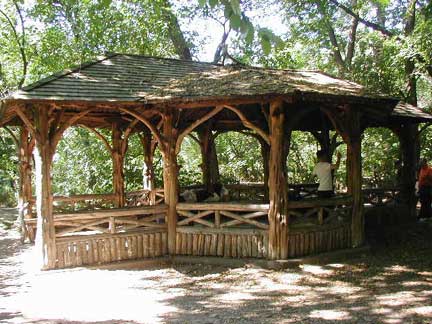
After a busy afternoon rambling in Central Park’s central maze, The Ramble, you might just stumble on the Ramblehut, probably the coolest (in its literal sense) of Central Park’s rustic shelters. It’s a good ten degrees cooler underneath that timbered roof.
However, shelters aren’t the only things constructed entirely of wood in Central Park…there is all manner of small bridges, fences and even benches fashioned entirely of ligneous materials.
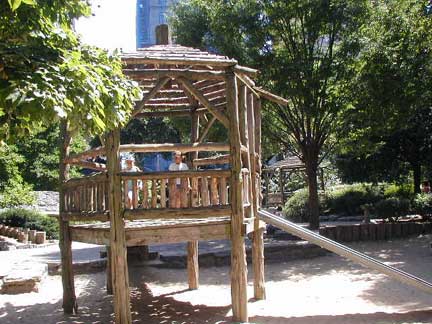
A kids’ playhouse in a nearby playground echoes the rustic shelter theme.
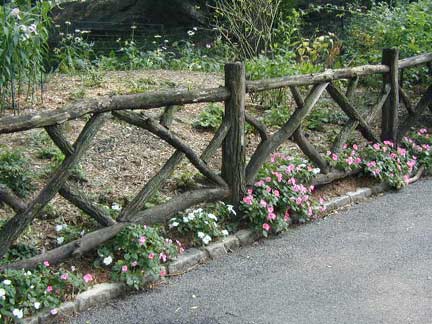
Fence along path in Shakespeare Garden
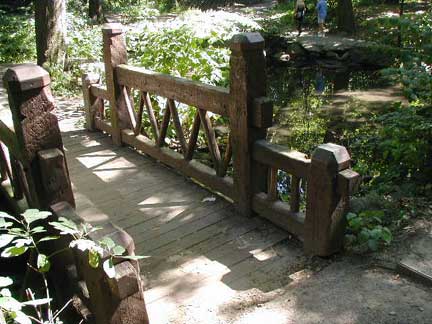
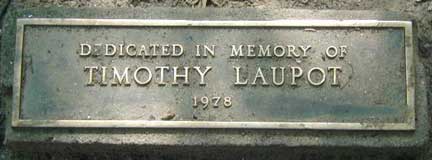
More than one Forgotten Fan has pointed out who Timothy Laupot is:
In the death notices in the 8/23/1967 New York Times is the entry for Timothy Laupot, aged 12 years, who died suddenly on 8/20. This is followed by a second notice placed by the Officers & Board of Trustees of the Larchmont Temple. So Tim is remembered, perhaps forever, here in The Ramble. His family may have placed this marker here in 1978.
The Ramble contains a number of wooden bridges, including this one that crosses the small stream called The Gill (it is actually man-made and is fed by a pipe connecting it to the Central Park Reservoir). The Ramble is one of the least-known and less-visited parts of the park, since its very isolation renders visitors open to attacks by muggers. While exploring, stay alert. Among the Ramble’s attractions are The Cave, closed off in the 1920s but still visible along with a stone staircase leading to it; Tupelo Meadow; the Humming Tombstone, a rock that hides the control boxes for the park’s lampposts; Azalea Pond, a favorite of birdwatchers; and the massive Ramble Arch.
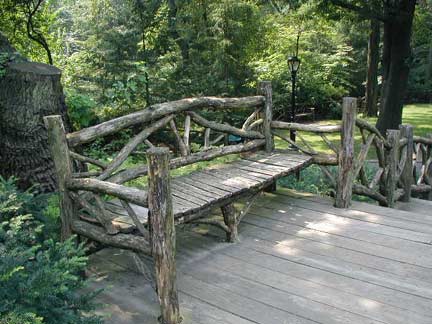

These two rustic benches are located between the Shakespeare Garden and our next attraction…

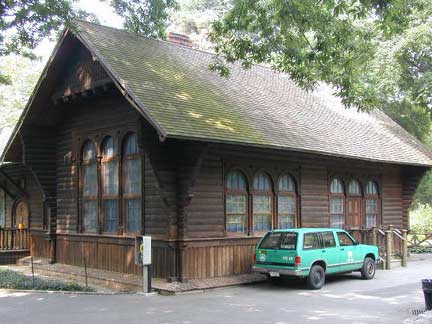
I’M YOUR PUPPET
The Swedish Cottage was actually built in Sweden, in 1876. It originally appeared in Philadelphia at its Centennial Exhibition and was disassembled and reassembled in Central Park the next year, after having been purchased for $1500. It has found use as a storage shed, a public restroom, an insect lab, a Civil Defense headquarters and, since 1947, as a marionette theater. It is just east of the Natural History Museum on Central Park West.
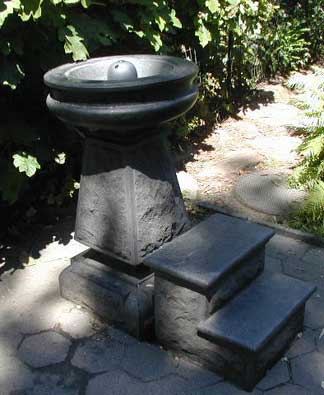
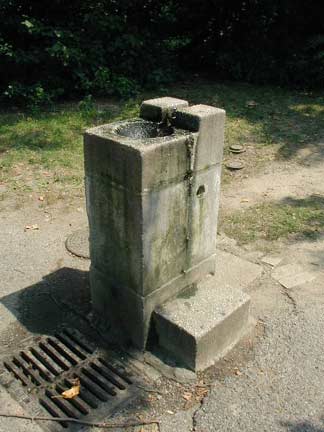
DESIGNER DRINKS
There’s a drinking fountain for every mood in Central Park. You have your boxy concrete number from the Heavenly Seventies on West Drive, or your more jazzy number of more recent issue nearby, with helpful steps for the little ones.
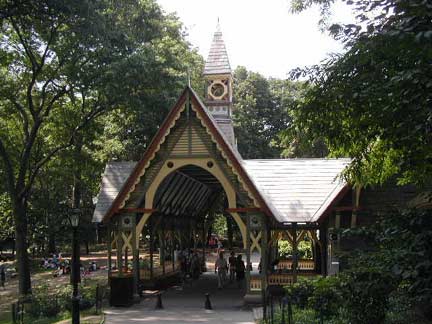
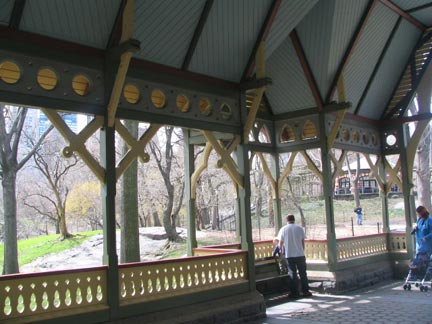
SAFE AS MILK
There was once a time in the past when it was difficult to get clean, fresh milk, before the age of pasteurization. City children were sickened, some to death, from tainted milk. In both Central Park and Brooklyn’s Prospect Park, facilities were set up that allowed people to obtain milk from authorized producers back when every nutritionist in the world swore that whole milk was good for you (now they say skim milk is the only way to go).
Central Park’s Dairy was designed by Calvert Vaux and built in 1870, and is the hub of the park’s Children’s District: the Zoo is to its east and the Carousel is to its west. The Victorian Gothic building added coffee and sandwiches to its repertoire and was a lively gathering place until the early part of the 20th Century. Then the rot set in, accelerated by the Depression; the decaying Dairy was used as a storage shed by the 1950s. The Central Park Conservancy succeeded in restoring the Dairy to its former glory by 1980 and today it serves as the park’s Visitor Center, though you have to go elsewhere in the park for milk or other beverages.
Both Central and Prospect Parks feature mid-park lakes that afford fascinating vistas of the surrounding park and city. Their lakeside shelters are unremarked-on in the official guides but they are welcome oases from the hot sun.
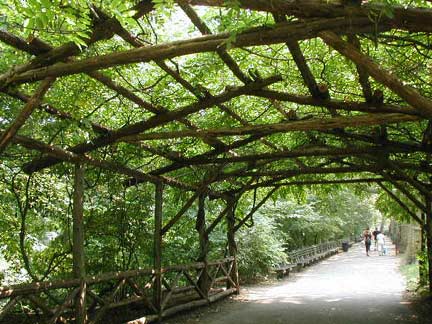
A shady wisteria arbor can be found on the park path along the Lake’s southwest side.
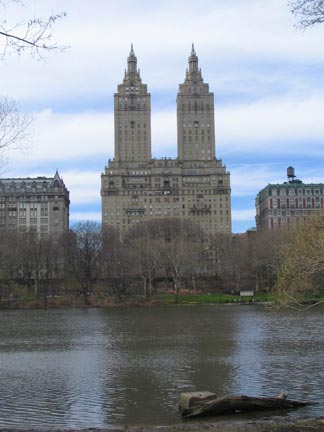
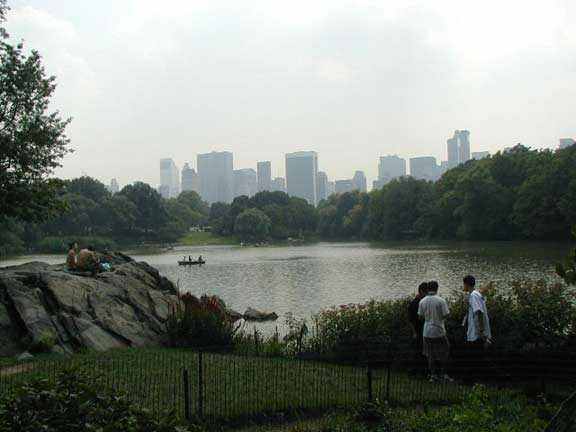
HERNSHEAD
To find another of the park’s many surprises you have to make a detour along the park path along the west side of the lake. A short peninsula juts into the lake, affording stellar photo opportunities. On this day a bathing-suited pair rested on the rocks while some high school guys were hunting bugs. While I was there, bugs were all they talked about. You’d think they would notice the bikini girls, but they were all business.
“Hernshead” is Anglo-Saxon for “heron head” but according to birdwatchers, the wading birds like herons and egrets stay away from Hernshead for the most part. A curving path takes you through a maze of flowering vegetation until you are lakeside, which affords a good view of the massive San Remo Apartment towers, built in 1929.
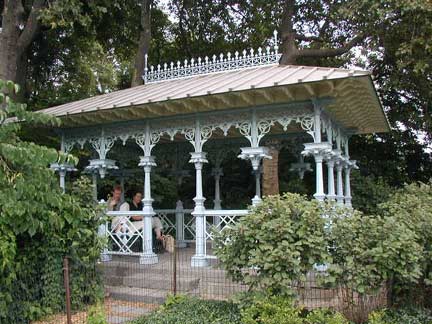
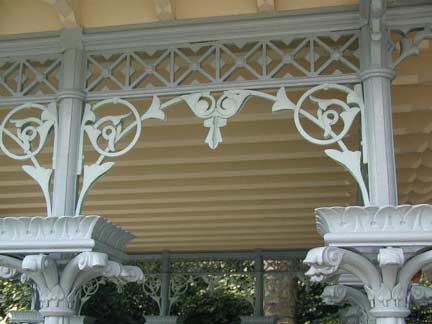
The crown jewel of Hernshead, though, is undoubtedly the Ladies’ Pavilion, which dates back to 1871 and was designed by Jacob Wrey Mould, who also “moulded” the concrete creations at Terrace Bridge (see the bridges page referred to above). It was originally a trolley car shelter at Columbus Circle, but after years of rust and neglect (a theme in Central Park) it was taken apart, repaired and reassembled in the early 1970s. The elements and vandals are always on the attack and the Pavilion has had to be renovated again at intervals in subsequent years.
The Ladies’ Pavilion is so named because it took the place of the old Ladies’ Shelter, which gave women skating at the old Ladies’ Pond site the opportunity to change from shoes to skates without losing their dignity, a shocking glimpse of stocking and all that. It was likely moved to Hernshead around 1913.
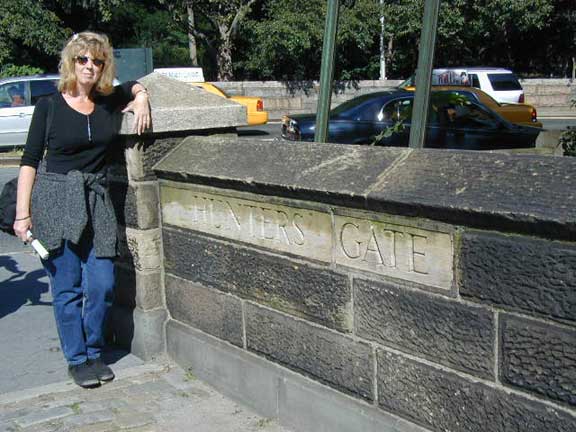
GATED COMMUNITY
Forgotten Fan Mary Beth poses at Hunters’ Gate on Central Park West and West 81st Street. Park masterminds Olmsted and Vaux whimsically named several main park exterior openings as ‘gates.’ Running clockwise around the park from Columbus Circle they are:
Merchants’ Gate: Columbus Circle
Women’s Gate: Central Park West at West 72nd Street
Explorers’ Gate: CPW at West 77th Street
Hunters’ Gate: CPW at West 81st Street
Mariners’ Gate: CPW at West 85th Street
All Saints’ Gate: CPW at West 97th Street
Boys’ Gate: CPW at West 100th Street
Strangers’ Gate: CPW at West 106th Street
Warriors’ Gate: Central Park North at Adam Clayton Powell Blvd. (7th Avenue)
Farmers’ Gate: CPN at Malcolm X Blvd. (Lenox Ave.)
Pioneers’ Gate: Duke Ellington/James Frawley Circle at 5th Avenue
Vanderbilt Gate (only gate named for a person): 5th Ave. at East 106th Street
Girls’ Gate: 5th Avenue at East 102nd Street
Woodmen’s Gate: 5th Avenue at East 96th Street
Engineers’ Gate: 5th Avenue at East 90th Street
Inventors’ Gate: 5th Avenue at East 72nd Street
Scholars’ Gate: 5th Avenue at East 60th Street
Artists’ Gate: Central Park South at 6th Avenue
Artisans’ Gate: CPS at 7th Avenue
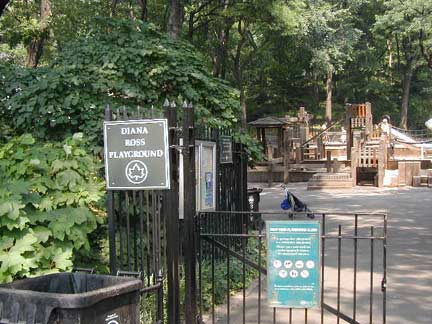
And speaking of divas (sorry, Mary Beth) the Diana Ross playground at Central Park West and West 81st Street was conceived under unusual circumstances. After Diana Ross’ scheduled free concert in 1983 was cut short by torrential rain and wind, she returned for a second show the following night; the crowd erupted into a near-riot, causing some damage. Ross subsequently funded this playground that bears her name perhaps in atonement.
SENECA VILLAGE
What was in Central Park before the park was built? Not a lot, since the city had not yet made much headway as far north as the settled-upon park site by the mid-1850s when construction began. Still, there were small settlements here and there, such as Seneca Village, at about West 85th Street, which by the mid-1850s was home to a few hundred Germans, Irish and “free” blacks. Another settlement, York Hill, was at about East 88th Street, or rather, where it would eventually be. A nearby town, Yorkville, retained a German flavor well into the 20th Century. The settlements would be summarily torn down and the residents moved out, in Robert Moses fashion, once the Central Park site was settled on.
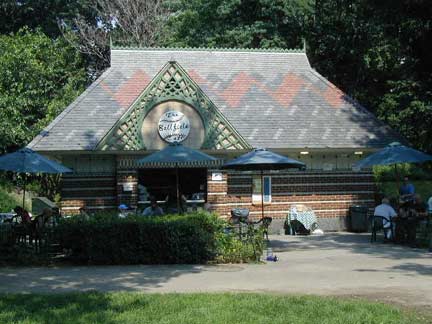
BUY ME SOME PEANUTS AND CRACKERJACK
I remember a NY Times commercial twenty years ago in which they took the first word out of “Take Me Out to the Ballgame” and sang it that way. I still remember how it sounded but I forget the point they were trying to make. Anyway, this Victorian-styled building is a replica of the original Ballfields Cafe, which stood from 1873 to 1969. You can get hot dogs, sodas and sandwiches watching the ballplayers and listening to the music from the nearby Carousel.

A pair of these ornate lampposts stand next to the Hans Christian Anderson statue along Conservatory Lake west of East 74th Street. Hey wait…there’s bird seed where the lightbulbs should be!
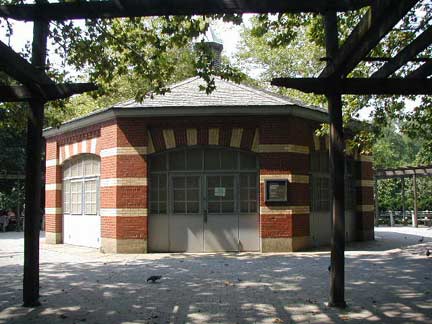
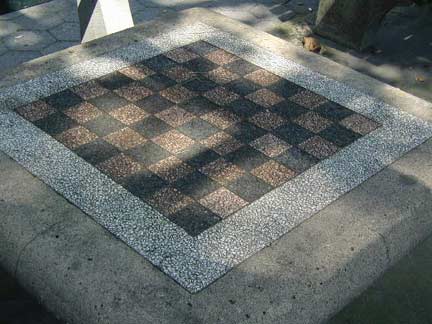
The Chess and Checkers House is one of Central Park’s newer additions, dating to 1952. There are indoor and outdoor tables. This replaces Central Park’s largest rustic wood shelter; the remaining ones are shown at the top of this web page.
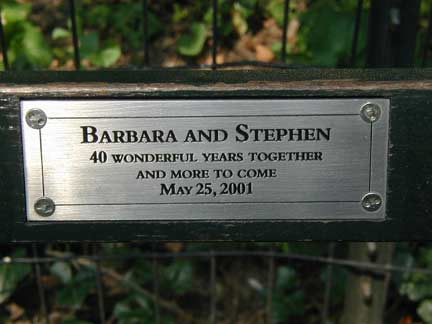
The Dull Men’s Club claims there are over 8500 park benches in Central Park alone. A lot of them are dedicated to various individuals.
What? Your webmaster is occasionally dull, and unapologetic about it.
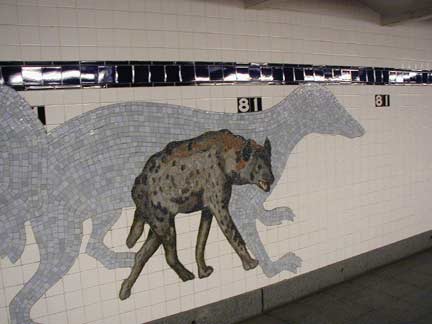
CRACKING THE CODE:
Mosaics celebrating the Natural History Museum can be found at the IND 81st Street station. On the northbound platform, extant species get the full treatment, but extinct species are grayed out.

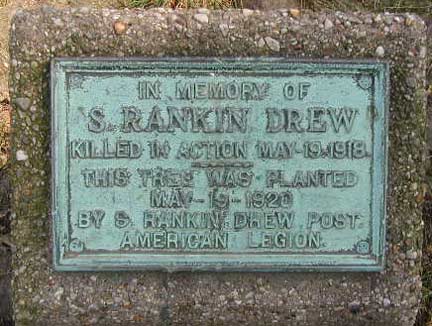
It’s just a big oak tree near Wagner Cove, but this one’s different: it’s named. It was planted by the American Legion in 1920 in remembrance of S. Rankin Drew.
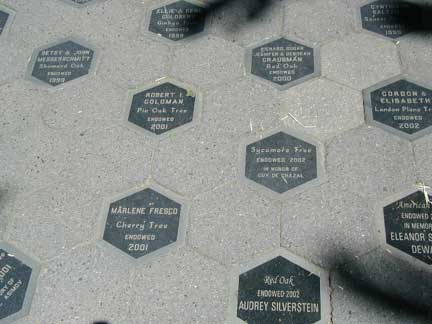
The benches have names. The trees have names. And, so do the paving stones along Literary Walk at The Mall. The Central Park Conservancy sponsors tree endowments, with a paving stone the award for a $5000 endowment.
![]() Who Are Those Guys? Statues of Central Park
Who Are Those Guys? Statues of Central Park
8/31/2003

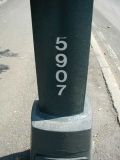
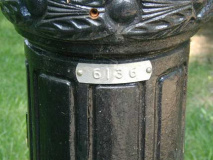
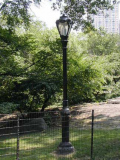


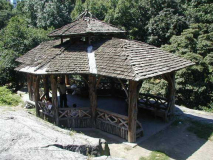
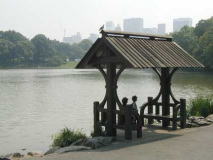
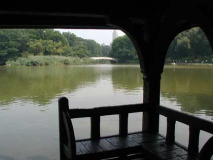
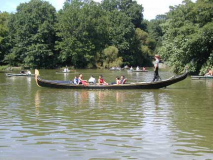
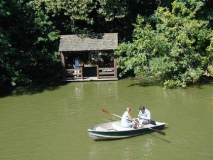
10 comments
Can anyone tell me about the big slide in Central Park? I remember it vaguely from my childhood. We were pretty poor growing up, but once in a while my Mom and Dad would take us 5 kids on the subway over to Central Park and we’d enjoy the day. I remember sliding on a big long marble(?) slide. Using bread bags or cardboard haha.
I like to take walks through Central Park every now and then. A couple of things that should be noted though. Yes, I know this post is almost 10 years old, but I felt the comments should be made anyway.
First, regarding the numbers on the lampposts: I’ve always seen a four-digit number on the lampposts that have numbers on them. Some of those walks through Central Park I take include portions north of 100th Street (Harlem Meer, North Woods, Great Hill, etc). Even those lampposts have 4-digit numbers, so for example, if you see a lamppost with the number 0123, you’re somewhere around 101st Street.
Next, I also remember that NY Times commercial. If I remember correctly, the ads aired either in the late 80’s or early 90’s (as I recall seeing it around or during episodes of Star Trek: The Next Generation), and the point they were trying to make was that the Times had the city’s most complete sports coverage (comparing other newspapers’ coverage to the song sung in the commercial).
Thanks for the information. However, I’m still interested in knowing the significants of all the numbers on the lamp post. The cross Street numbers arelogical but what about the numbers after the street numbers What are the significants of those numbers and what is their logic?
Thank you for responding.
I don’t know about those…
I’m extremely interested in the lamp posts by Mr. Henry Bacon. I live near a very small community that has the exact post-tops designed by Gerald Allen and Kent Bloomer in the 1980’s for Central Park. My search for replacing them began when I found “1986 Allen Bloomer” printed inside of the one that the mayor sent me back to work with this morning to try and help find a replacement. The lamp posts (which are not a Bacon) are still in very good condition. The post-tops are in fine condition, as far as the iron goes, but the globes are horribly beaten and broken. Not to mention yellowed from the weather. I can’t seem to find a replacement for neither globes or the post-tops. Any information would be wonderful!
I, also, am in need of a replacement globe. I have one post. I can tape/super glue or otherwise construct this yellowed dry rotted globe but for all the time & expense to install it …. IT WOULD BE GREAT TO GIVE IT A NEW GLOBE.
. Did you ever find out how to get a replacement? Any help you can give me would be GREATLY APPRECIATED.
[…] are four numbers on each lamp post: The first two digits tell you the nearest street (if higher than 100, the first 1 is omitted), and the second two digits […]
[…] are four numbers on each lamp post: The first two digits tell you the nearest street (if higher than 100, the first 1 is omitted), and the second two digits […]
[…] are four numbers on each lamp post: The first two digits tell you the nearest street (if higher than 100, the first 1 is omitted), and the second two digits […]
I remember finding a cave around Rowboate Lake. The entrance is sealed with iron bars, Do you know where this point is located?? I was 12 years old when this was found.